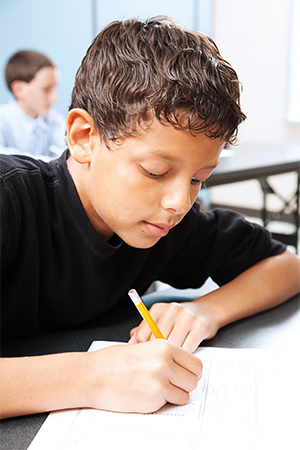How do you measure infant, child, or student performance?
Page 2: Identifying a Progress Monitoring Measure
 One of the best ways to measure an individual’s improvement is through progress monitoring, specifically general outcome measures (GOMs). GOMs are a type of formative assessment conducted on a regular basis to assess young child or student performance throughout an entire year’s curriculum. Each test, or probe, assesses skills taught from the beginning of the year to those taught at the end of the year. GOMs are:
One of the best ways to measure an individual’s improvement is through progress monitoring, specifically general outcome measures (GOMs). GOMs are a type of formative assessment conducted on a regular basis to assess young child or student performance throughout an entire year’s curriculum. Each test, or probe, assesses skills taught from the beginning of the year to those taught at the end of the year. GOMs are:
progress monitoring
A form of assessment in which student learning is evaluated on a regular basis in order to provide useful feedback about performance to both learners and instructors.
- Easy to implement
- Quick to administer
- Cost-effective
- Can be administered frequently (e.g., once per week)
- Sensitive to change in child or student performance
- Used to evaluate progress for physical, cognitive, academic, social-emotional, or behavioral skills or domains
Listen as Tom Kratochwill identifies two reasons why progress monitoring is important. (time: 0:54).

Tom Kratochwill, PhD
Professor, Educational Psychology
Co-PI, Project PRIME, University of Wisconsin-Madison
Transcript: Tom Kratochwill, PhD
Progress monitoring is important for two reasons. One is that it is absolutely essential to know if your student is making progress in the target area of concern. So in an academic curriculum area, for example using a curriculum based assessment method, you want to know whether they are meeting benchmarks of progress, whether their progress is on line with the goal that you have set up for them. The second reason for the importance of progress monitoring measures and using them in practice is to consider that if the student is not making progress that you may need to change the intervention or instructional procedure that you’re using.
The first step in progress monitoring is to identify a GOM that assesses the skills targeted by the EBP. The type of progress monitoring measure you will use will depend on the age of your children or students. Additionally, some sources offer non-English language versions of the measures for linguistically diverse students and large-print versions for those with visual disabilities.
Infant and Toddler Progress Monitoring Measures
For infants and toddlers, ages 0–3 (typically 6–36 months), general outcome measures target developmental skills. For this age group, progress monitoring measures are just beginning to emerge. One set of measures available to monitor infant and toddler growth and progress is the Individual Growth and Development Indicators (IGDIs). To administer an IGDI, an observer records the child’s responses during a six-minute semi-structured play session with a familiar adult. IGDI measures are available for the following developmental areas:
Sample Infant and Toddler GOM Resources
- Communication (Language)
- Problem Solving (Cognition)
- Movement (Motor)
- Social (Social-Emotional)
Example: To assess an infant or toddler’s communication skills, a familiar adult plays with the child with either of two toys, a toy barn or a toy house. The adult lets the child lead the play. The number of utterances the child makes is recorded.
Listen as Jay Buzhardt describes the IGDIs in more detail (time: 1:45).

Jay Buzhardt, PhD
Associate Research Professor, Early Childhood Special Education
The University of Kansas
Transcript: Jay Buzhardt, PhD
With infants and toddlers, you want to have them in a more authentic situation demonstrating skills that maybe aren’t able to be picked up in a standardized administration. So there’s that balance between getting an authentic assessment and doing a standardized administration. With the infant and toddler IGDIs, they’re an observational tool, and there’s four different domains: There’s communication, problem-solving, motor skills, and social skills. For each one of those, there’s a set of scoring definitions that an observer will count. Basically, how many instances of communication a child demonstrates during a six-minute semi-structured activity. We’ve got toys for each one of those four assessments that we recommend that folks use. You’ve got an adult play partner with the child, and for six minutes they essentially play together. So rather than sitting a child in front of you and presenting items, or asking them to do very specific things to demonstrate their skills, it’s really about an authentic play environment. For example with the ECI, the Early Communication Indicator where we’re measuring growth and pre-linguistic and linguistic communication, we’re just looking to see how much they communicate and use language with that adult play partner during a six-minute play assessment or play situation.
Early Childhood Progress Monitoring Measures
For preschool children ages 3–5 (30–66 months), general outcome measures target developmental, functional, and early academic skills. Progress monitoring measures for this age group are commercially available (e.g., myIGDIs, PELI) but are still being researched and expanded. At this time, measures are available for the following areas:
Sample Early Childhood GOM Resources
- Early Literacy
- Expressive Language
- Vocabulary
- Phonological Awareness
- Alphabet Knowledge
- Comprehension
- Early Numeracy
- Oral Counting
- Number Naming
- Quantity Comparison
- One-to-One Correspondence Counting
- Writing
- Social-Emotional skills
Example: To assess a preschooler’s expressive vocabulary skills using myIGDIs, an adult presents a series of photos of commonly occurring objects (e.g., banana, dog) for one minute. The number of correctly named objects is recorded.
Listen as Scott McConnell discusses progress monitoring for preschool children in more detail (time: 2:35).

Scott McConnell, PhD
Professor, Educational Psychology
University of Minnesota
Transcript: Scott McConnell, PhD
Progress monitoring measures for preschool kids ages three to five is a pretty active area of research and practice development right now. So that means that there are some ideas, but there will probably be more ideas and more measures in the coming years. The idea of progress monitoring in preschool is that we want to measure children’s acquisition of a general set of skills, like language or numeracy, and we do that by using a common set of measures that we administer repeatedly. And we look for growth on the child’s performance across those different times that we’ve measured them. And because we’ve done that with lots of kids, we have expectations or norms for how quickly a child should grow over time and what level of performance they should be demonstrating at any particular point in time. We can use those to evaluate kids’ individual performance and identify children that are meeting expectations and seem to be on a path towards acquiring these long-term goals that we have for them, or children who aren’t yet on that path and might need additional assistance. It’s those children that need additional assistance that we most typically use the same measures in a progress monitoring way.
Typically, progress monitoring means that we’re applying those same general outcome measures or general measures of child performance, but we’re doing it frequently—so every couple of weeks, every month—and then using the child’s performance like a height and weight chart to evaluate whether our intervention is promoting their development, accelerating their growth towards those long term goals, or not yet accelerating their growth towards those goals, and that we need to change the intervention. The general idea in progress monitoring is that you want to measure frequently enough that you’re noticing small changes in a child’s performance so that you can adjust intervention. So you want to be able to assess more often than you could change intervention. So if you can change intervention once a month, you’d want to be able to assess a couple of times during that month to see whether that adjustment is needed or not. The preschool IGDIs were designed for classroom teachers and assistant teachers and sort of anybody who spends time with little kids to be able to administer. They’re administered individually. They’re administered in a way that’s standardized, so we want each assessment occasion to be very similar to the last one. But they’re pretty easy to do. If you have any experience working with kids, you can do it. For the preschool measures, you literally have to ask a child a question, and it’s a thing like the child looks at a picture of an orange and you say, “What is this?” And if they say, “Orange,” you count that as correct, and if they say anything other than “Orange” you count that as incorrect. So that’s pretty easy.
K–12 Progress Monitoring Measures
In K–12 education, GOMs are commonly referred to as curriculum-based measurements (CBM). The use of curriculum-based measures is an evidence-based practice for students in grades K–12. These measures and procedures are well established for the following domains:
K-12 CBM Resources
- Math
- Reading
- Vocabulary
- Writing
- Behavior
Click here to view a sample progress monitoring probe.
Listen as Pam Stecker and Lynn Fuchs discuss progress monitoring measures, specifically curriculum-based measurement.

Lynn Fuchs, PhD
Nicholas Hobbs Chair of Special
Education and Human Development
Vanderbilt University, Nashville, TN
(time: 1:57)
Transcript: Pam Stecker, PhD
Although progress monitoring is an appropriate practice in general to help teachers gauge how well their students are learning, curriculum-based measurement (or CBM) is known as a particular type of progress monitoring that is supported by research. With CBM, a specific set of procedures are used for developing, administering, and scoring progress-monitoring tools, and teachers apply data-based decision rules when looking at the student’s graphed scores. After first determining that CBM tools were reliable and valid and that they were sensitive to changes in students’ academic performance, a series of experimental-contrast studies were conducted to determine whether teachers who used CBM brought about greater growth among their students than teachers who did not use CBM. The evidence indicated that teachers who used CBM—that is, they did not just collect data but used that data for determining when to make instructional modifications in their students’ programs—did, indeed, produce significantly greater growth among their students than teachers who used their own progress monitoring methods. These studies included students in elementary and middle schools who had mild to moderate learning and emotional/behavioral disabilities and addressed different academic domains, such as mathematics and literacy.
Because CBM tools are relatively quick to administer and easy to score, teachers should be able to give them frequently (for example, every week) and can chart how well their students are progressing in the curriculum. Teachers are able to determine how well students are progressing toward a year-end target. More specifically, teachers use the graphed data to determine when their instruction seems to be working as desired or not working. For many students with disabilities, teachers periodically will need to modify or intensify their instruction to bring about better individual growth. Teachers can use CBM graphed data to decide objectively whether these instructional changes are effective and to determine which instructional modification appears to be working the best. Because we know that teachers can bring about better student achievement when they use CBM to inform their instructional decision-making, CBM enjoys many benefits and remains an important evidence-based assessment practice. A number of online versions of CBM are available that enable teachers to administer and to score measures efficiently. Many of these programs also manage student data by storing and displaying student scores and graphs automatically. Some systems even display class graphs for teachers who monitor large groups of students.
Transcript: Lynn Fuchs, PhD
It’s almost always the case that progress monitoring probes that sample the entire year’s curriculum, rather than a single skill, will provide teachers with more useful information for program planning but also be more representative of the student’s overall response to the curriculum. Sampling the annual curriculum in the same way over time, we can compare a student’s performance in October to a student’s performance a month later and a month after that and so on, which helps us understand their response to the overall program, not just a particular skill in the program. When we have a single skill that’s used for progress monitoring, it’s not unusual for teachers to fix on that particular skill for instruction. The student improves on that skill, and the school uses that as evidence that the student has responded and no longer has difficulty, but it’s only a single skill. Multiple skills representing the annual curriculum that will work well to provide accurate progress monitoring information. I think it’s very important when you’re progress monitoring to represent the comprehensive curriculum, and that way we can pinpoint students who are having difficulty in some components but not others. And that way we can gear instruction to the kinds of difficulties students are specifically experiencing. And if we don’t have the entire curriculum represented then we run into problems where we get falsely optimistic about a student’s performance, but we don’t have the whole curriculum worth of information to understand where there may be some serious problems.
